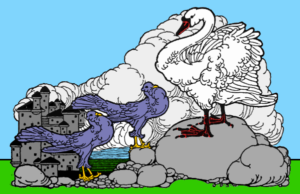Player conflict is a problem that all GMs must face at least once in their life. It may result from any number of causes. But regardless of the cause, it can result in a total disintegration of the gaming group. Even if everything else is going well, two players (or their characters) being antagonistic towards one another can ruin the game for everyone.
Category Archives: An Analysis of GMing (Game On!)
GMing (Part 6): Beginning a Campaign or Session
Last time, we talked about running a game session. However, there is an important corollary that goes along with this idea. That is the the understanding of how to begin a game session. But this concept of a beginning doesn’t apply exclusively to game sessions: the beginning of a campaign is just as important (in some ways, more so!). So we’re going to talk about beginning things in today’s session
GMing (Part 5): Running the Game Session
Finally, the time has come to play! You’ve assembled a gaming group and you’ve chosen a game. You designed the campaign, and you’re ready with the story for the first session. Now you’re sitting at a table with your friends, dice nearby, and the players all look at you. What do you do now?
GMing (Part 4): Preparing a Game Session

A swan telling a story. Much like the GM tells a story to the players in a game session, often of fantastical tales, such as a swan telling stories
I have one more post to write on Gen Con. But we’ve been hearing about Gen Con for months now. Let’s take a break before we finish it up. It’s been a long time since we’ve had any installments on the Analysis of GMing series. Let’s get another one of those in! This time, we’ll talk about planning a game session.
So you’ve chosen a game, gathered a group of players, and have a design for the overall campaign. It’s time to start getting into the nitty-gritty. Before you meet up with your players for that first session, you need to know what’s going to happen in that session. So let’s take a look at that.
How to GM Part 3: Designing Your Campaign (2nd of 2)
 Last week, we began looking at the essentials of designing your campaign. It was a big topic, so I had to split it into two sections. Today’s entry will finish what we started, as we look at the remaining three basic campaign arrangements. In case you’ve forgotten, last week we discussed the ‘Episodic’ and ‘Set-Piece’ design systems. Today, we will cover ‘Branching,’ ‘Puzzle Piece,’ and ‘Enemy Timeline.’
Last week, we began looking at the essentials of designing your campaign. It was a big topic, so I had to split it into two sections. Today’s entry will finish what we started, as we look at the remaining three basic campaign arrangements. In case you’ve forgotten, last week we discussed the ‘Episodic’ and ‘Set-Piece’ design systems. Today, we will cover ‘Branching,’ ‘Puzzle Piece,’ and ‘Enemy Timeline.’
